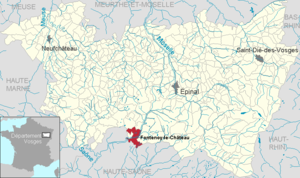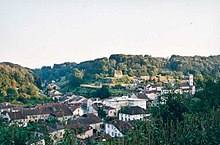Fontenoy-le-Château
| Fontenoy-le-Château | ||
|---|---|---|

|
|
|
| region | Grand Est | |
| Department | Vosges | |
| Arrondissement | Epinal | |
| Canton | Le Val-d'Ajol | |
| Community association | Epinal | |
| Coordinates | 47 ° 58 ′ N , 6 ° 12 ′ E | |
| height | 247-461 m | |
| surface | 34.60 km 2 | |
| Residents | 532 (January 1, 2017) | |
| Population density | 15 inhabitants / km 2 | |
| Post Code | 88240 | |
| INSEE code | 88176 | |
 Location of the commune of Fontenoy-le-Château in the Vosges department |
||
Fontenoy-le-Château is a French commune with 532 inhabitants (as of January 1, 2017) in the Vosges department in the Grand Est region . It belongs to the Arrondissement Épinal and the municipal association Épinal .
Due to its location on the Canal des Vosges , the old buildings, cobblestone streets and a ruined castle, the community has become a tourist magnet today.
geography
The municipality of Fontenoy-le-Château is located at an altitude of 250 to 280 m above sea level, 6 km southwest of Bains-les-Bains in the extreme south of Lorraine on the border with the Franche-Comté region , more spaciously in the middle of the triangle Vittel - Épinal - Vesoul .
The area of the 34.6 km² municipal area comprises a section of the Vôge plateau east of the upper Saône valley . The Saône tributary Côney divides the municipality into a north and a south half and at the same time forms the north-eastern border to the municipality of Bains-les-Bains over a length of 3.5 km . The alluvial valley of the Côney is an average of 250 m and has a maximum width of 300 meters. Fontenoy-le-Château is the only municipality with a closed development on both sides of the Côney and the parallel Canal des Vosges.
From the river valley of the Côney the community area extends northward over a steep slope to an agriculturally used plateau, which reaches a height of 300 m.
Further to the northwest, the striking terrain of the Coupes Mouray rises to heights of up to 460 m. These heights in the north-west of the municipality are wooded ( Bois de Montroche ). Coming from the north, the Côney flows into the Ruisseau de Quicorne and Ruisseau de Gruey , from the south the Ruisseau de Falvinfoing and the Ruisseau des Arsondieux . The area south of the Côney Valley rises gradually to 410 m above sea level. The two ponds Etang des Arsondieux and Etang des Breuillots are located near the district of Les Grosses Granges . These are two larger of the total of 30 ponds in the municipality. On the south-east and south-west borders of the municipality, forest areas dominate that belong to the forests of Bois Saint-Georges , Le Grand Bois and Bois du Lyaumont .
Fontenoy-le-Château includes the villages and hamlets of La Vierge, Les Baraques, Les Grosses Granges and Les Molières, as well as the village of Le Magny, which was incorporated on January 1, 2013 .
Neighboring municipalities of Fontenoy-le-Château are Gruey-lès-Surance and Hautmougey in the north, Bains-les-Bains in the northeast, Trémonzey in the east, Aillevillers-et-Lyaumont in the southeast, Bouligney , Cuve , Dampvalley-Saint-Pancras and Betoncourt- Saint-Pancras in the south, Fontenois-la-Ville and Mailleroncourt-Saint-Pancras in the southwest and Ambiévillers and Montmotier in the west.
history
In 1050 a castle was built by the bishops of Toul to monitor the Côney crossing . The towns of Fontenoy-le-Chastel on the left and Fontenoy-la-Coste on the right bank of the Côney were built around the castle, which later grew together. Fontenoy was the southernmost Lorraine outpost on the border with Burgundy. In 1360 the place came to a Burgundian noble family. The area around Fontenoy, called terres surséance , was disputed for centuries between the county of Burgundy and the Duchy of Lorraine . From 1508 on, there were several contracts to belong to the area. It was not until the Treaty of Besançon between Louis XIV and Duke Leopold of Lorraine , signed on August 25, 1704, that the border was finally determined. Fontenoy finally came to Lorraine with a few other villages. From 1704 to the French Revolution, Fontenoy belonged to the Bailiwick of Remiremont in Lorraine, but ecclesiastically still to the parish Fontenois-la-Ville in the diocese of Besançon (Franche-Comté) until 2000 .
The church was rebuilt in the second half of the 15th century. It is dedicated to Saint Mansuy ( Mansuetus ), who was Bishop of Toul from 338 to 375.
From the 16th century, Fontenoy experienced an economic boom. In the place was an important center for the production of flat glass and mirrors. An important trade route ran through Fontenoy over the low Rhine-Rhône watershed, so that many residents earned their living as carters who brought the glass to Antwerp, Bruges, Frankfurt, Geneva, Basel, Florence, Venice and Lyon. In the 17th century the production of schnapps was added, which was distilled from cherries and sold far beyond the borders of the region. Numerous blacksmiths in Fontenoy and the surrounding area (nail and wire production) also brought a certain degree of prosperity. Until the time before the French Revolution, the local markets had their own weights and measures ( mesure de Fontenoy ).
During the Thirty Years War the castle was destroyed and Fontenoy was devastated. The war and associated epidemics brought economic decline. The edict of Fontainebleau that followed in 1685 also drove many traders from Fontenoy. In the middle of the 19th century the economic situation of the community slowly recovered. The basis for this was embroidery, which reached its peak in 1873 when 500 residents of Fontenoy were employed in embroidery factories.
The creation of a small port on the Canal des Vosges , which was completed in 1884 and runs through the middle of Fontenoy, brought further economic growth.
The last embroidery was closed in 1976. The embroidery museum inaugurated in 1978 is a reminder of the long tradition.
Population development
| year | 1962 | 1968 | 1975 | 1982 | 1990 | 1999 | 2006 | 2017 | |
|---|---|---|---|---|---|---|---|---|---|
| Residents | 920 | 979 | 863 | 785 | 729 | 666 | 694 | 532 | |
| Sources: Cassini and INSEE | |||||||||
Attractions
- entire old town ensemble
- Castle ruins
- Saint-Mansuy church, every August 15th a Marian procession ends here
- Embroidery Museum ( musée de la broderie )
- Statue of the poet Nicolas-Joseph-Laurent Gilbert
- Picture of the first French high school graduate Julie-Victoire Daubié on a house wall
- Marina
- Bois Banny chapel in the La Vierge district
- Saint-Mansuy church in Fontenoy-le-Château
- Bois Banny chapel in the La Vierge district
Economy and Infrastructure
The workers in Fontenoy-le-Château are mainly employed in the tourism industry, but also in agriculture and forestry as well as small service companies in the town or the surrounding area. 13 farms are located in the community (fruit and vegetable growing, dairy farming, cattle breeding).
A primary school ( ecole primaire communale ) and the Jean Poirot Medical and Pedagogical Institute are located in Fontenoy .
The D 434 trunk road from Épinal via Xertigny , Bains-les-Bains , Vauvillers to Vesoul is the main road through the municipality. The nearest train station (in Bains-les-Bains) is eight kilometers east of Fontenoy-le-Château.
Personalities
- Julie-Victoire Daubié (born 1824 in Bains-les-Bains, died August 26, 1874 in Fontenoy-le-Château), journalist, first French high school graduate in Lyon in 1861
- Nicolas Gilbert (born 1750 in Fontenoy-le-Château, died 1780 in Paris), French poet
- Abbé Constant Olivier (born in Fontenoy-le-Château in 1862, died in Fès, Morocco in 1919), historian
supporting documents
- ↑ Fontenoy-le-Château on cassini.ehess.fr
- ↑ Fontenoy-le-Château on insee.fr
- ↑ Farms on annuaire-mairie.fr (French)
- ^ Yannick Ripa: Femmes d'exception - les raisons de l'oubli . Éditions Le Chevalier Bleu, Paris 2018, ISBN 979-1-03180273-2 , pp. 103-111 .










